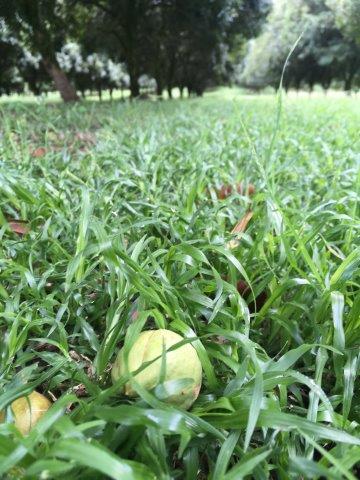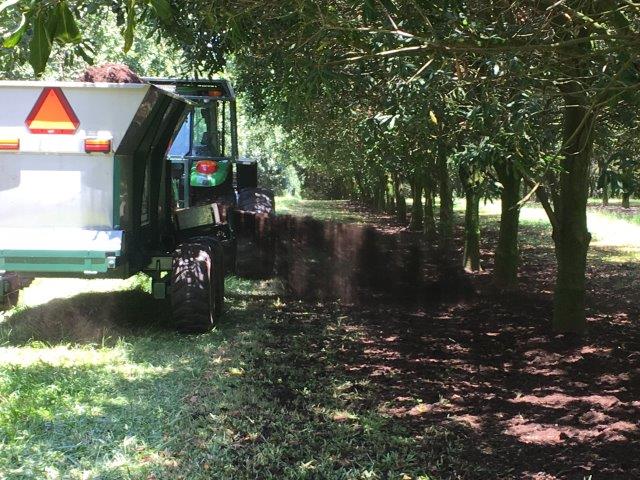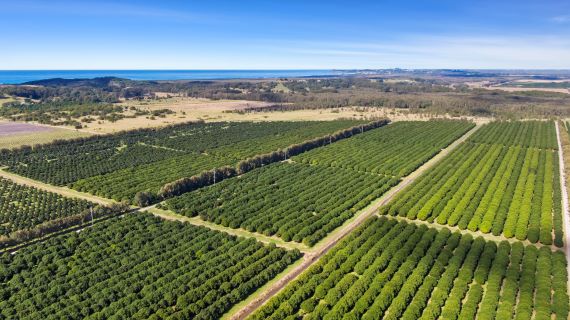
Searching for systems in macadamia nutrient management
14 August 2023
The Clean Coastal Catchments (CCC) Research team from the NSW Department of Primary Industries (DPI) has taken a 'systems' approach to identifying key knowledge gaps in the science of macadamia nutrient management. Using a systems analysis of macadamia production, our researchers Jeremy Bright and Daowei Sun aimed to better understand the fertiliser decisions that are made by macadamia growers.

“We used ‘systems thinking’ to identify and understand the drivers and barriers that macadamia growers may face when dealing with nutrient management and erosion on their farms,” explained DPI Research & Development Officer, Daowei Sun. Daowei worked closely with DPI Macadamia Development Officer, Jeremy Bright, to explore nutrient management from a grower’s perspective.
“We asked growers and other key stakeholders to tell us about their practices in farming and nutrient management, and what they saw as the barriers and knowledge gaps that limit their ability to improve orchard management,” said Jeremy.
Understanding fertiliser decision making
Agriculture is one of many industries acknowledged as contributing to nutrient run-off that accumulates in creeks, rivers and estuaries, which can lead to significant environmental problems. The CCC project, funded by the NSW Marine Estate Management Strategy, is tackling research knowledge gaps to help farmers better manage fertiliser applications and prevent diffuse pollution in coastal waters.
Ideally in a rain fed macadamia production system, fertiliser can be applied in the right amount, in the right place, and at the right time to match the tree’s phenological stage. Rainfall will then wash fertiliser through the soil to the active root zone of the trees where the nutrients will support maximum production. Unfortunately, conditions are not always ideal and opportunistic applications of nutrients timed for rainfall events can lead to excess nutrients being washed off the farm and into creeks and rivers.
“While research is important, it is the growers and key industry stakeholders who can make the biggest difference in addressing the problem of nutrient run off through practice change,” said Daowei.
"Growers know what best practice is, but the costs of implementation can be significant, and can come at a trade-off or significant risk to production. Research in the right areas will help address knowledge gaps and reduce the associated risks of practice change,” said Jeremy.
Before joining the NSW Department of Primary Industries (DPI), Daowei was trained in ‘systems thinking’ while completing his PhD in agricultural innovation adoption at the University of Queensland. Systems thinking’ is a process developed to understand complex systems, and Daowei has been applying this approach to CCC’s fertiliser management research with the macadamia industry. Systems thinking is helping to diagnose where further research should be undertaken, and to identify possible intervention strategies that will have the best chance of helping farmers to improve management practices.
The systems thinking analysis
The CCC systems thinking research set out to investigate three key questions:
- What are the decision making processes of macadamia growers related to fertiliser use on the NSW north coast?
- What are the drivers behind grower decisions on fertiliser use?
- What are the intervention strategies that could help macadamia growers achieve desirable changes in fertiliser management?
The ultimate aim of the research is to achieve the following outcomes:
- improved understanding of the decision-making process by horticultural growers regarding fertiliser application
- improved understanding of the key barriers and drivers for growers to adopt changes in land use practice
- better, more reliable information for growers in intensive agricultural systems in coastal NSW, that will enable them to respond to risks and change, and make more informed decisions about the management of nutrient and sediment runoff

As part of the systems thinking process, data was drawn from semi-structured interviews with seventeen key macadamia industry stakeholders including growers, consultants, fertiliser suppliers, a local government officer, and a macadamia industry organisation representative.
The interviews demonstrated that numerous factors influenced grower decisions about the rate and timing of fertiliser applications, including fertiliser prices and weather conditions, particularly drought or heavy rainfall.
Key findings
A key finding of the systems analysis was that some macadamia growers may be unintentionally over fertilising crops, which could lead to nutrients washing off the macadamia orchard and into the broader environment.
One of the critical drivers identified regarding potential over fertilisation, was that the fertiliser rates typically recommended to growers, were above the ideal range of elemental nitrogen application. Page 21 of the NSW DPI Macadamia Growers Guide 2022 (PDF, 3326.04 KB) outlines the current fertiliser recommendations for nutrient replacement in macadamia orchards.
However, a key problem with determining fertiliser application rates is the lack of scientific knowledge about how much nutrient is lost to the environment through volatilisation, to leaching into the soil, and to absorption by the macadamia tree that is not used for nut production. Each of these unknown factors may be contributing to inaccurate estimates of orchard fertiliser demand.
Another knowledge gap identified through the systems research interviews, was that the release rate of nitrogen, phosphorous and potassium from compost material was not well understood. Composts are often applied to improve soil health. If the latent elemental nitrogen in the compost blend is not factored into total farm nutrient inputs, routine addition of compost can result in excess nitrogen application.
Among the surveyed group of growers, the amount of compost applied varied from 20 to 50 tonnes per hectare annually. Composts are generally made of wood chips and chicken and/or cow manures, and contain low quantities of nitrogen, phosphorous and potassium. However, when added at high volumes composts may contribute significant additional amounts of these nutrients.
Improved understanding to help with better nutrient decisions

Systems analysis showed that further research on compost nutrient values and release rates would help growers to better meet their orchard nutrient requirements and move toward best practice ‘right amount, right time’ fertiliser application. Quantifying nutrient release rate values from composts will also provide consultants and fertiliser resellers with more reliable information to factor into fertiliser calculations and recommendations.
Systems thinking analysis has given the CCC Research team an enhanced understanding of the complexity of the fertiliser decision making process undertaken by growers. Recommendations from this research process also strongly support Integrated Orchard Management (IOM). The IOM strategy is considered a key tool for effectively addressing erosion and nutrient management in macadamia orchards (Bright, Alt, & Commens, 2016). The IOM approach focuses on ground cover, drainage and canopy management to improve orchard productivity and resilience.
For more information about CCC 'systems thinking' research, an Abstract outlining a presentation given by Daowei Sun at the 2022 Irrigation Australian International Conference & Exhibition” held in Adelaide in October 2022 can be downloaded from the Research Gate website.
The CCC Research project is working with growers and other key macadamia industry stakeholders to facilitate practice change in nutrient management. The objective is to support farm production and profitability, while improving water quality in coastal waterways and helping to protect the reputation of the macadamia industry with regard to environmental impacts.
- This article is based on a presentation delivered by Daowei Sun at the Irrigation Australia International Conference in 2022.
- Special thanks to CCC Research project colleagues Melinda Simpson and Dr Sophie Parks who assisted Jeremy Bright and Daowei Sun with the CCC ‘systems thinking’ research process.
- This article has also been published n in the Australian Macadamia Society News Bulletin - Spring 2023 edition

